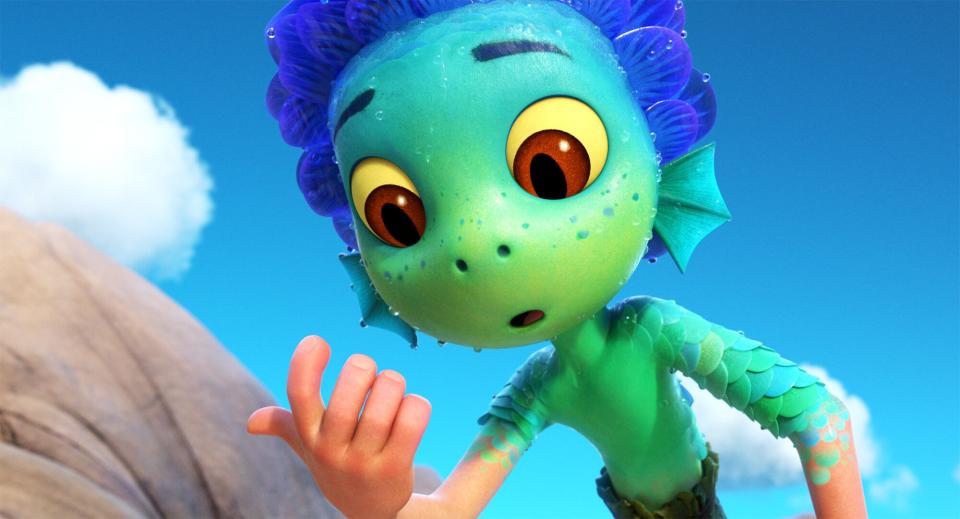How the team behind Luca broke the Pixar mold to create a 2D-inspired summer dream

Pixar is evolving. The last film released, Soul, which debuted in 2020, featured for the first time in the studio's storied 34-year history a Black lead character as the center of his own story. Pete Docter, who took over as Pixar's chief creative officer after John Lasseter's ousting in 2017, saw it as a strong step forward into a new direction for the studio. A year later, Luca, premiering on Disney+ Friday, continues down that new path, but the next step is more subtle.
Luca isn't as groundbreaking in the same way as Soul, nor does it pull on the heartstrings quite as deeply as something like Inside Out or Up. But it does break the mold that has become Pixar's signature visual style. Where the studio has veered more towards photorealism through CG animation, Enrico Casarosa, making his feature film directorial debut after making Pixar's 2011 short La Luna, took a different approach for their 24th movie - a story about two sea-monster best friends who appear as humans on land to have a gelato- and pasta-filled summer adventure.
"I'm a huge [Hayao] Miyazaki fan. So, I grew up with his films," the filmmaker tells EW of the Studio Ghibli co-founder behind Japanese movies like Spirited Away and Princess Mononoke. "There was even a TV series when I was growing up in Italy, Future Boy Conan. I showed that to all the [Pixar] animators."
"That is also about two boys getting into trouble and hijinks," Mike Venturini, the animation supervisor on Luca, says in a separate conversation of Future Boy Conan. "He thought there was some fun personality in there that he wanted us to be inspired by. We watched a lot of that in the beginning, and then we moved on to the greater Miyazaki library, which most animators at Pixar are familiar with and fans of." (Lasseter credited Miyazaki as a friend and inspiration.) "It wasn't hard to describe to people what that aesthetic was."

Disney/Pixar A concept sketch for Pixar's 'Luca.'
2D animation, even beyond the works of Miyzaki, became a prominent influence for Luca, which features the voice talents of Jacob Tremblay and Jack Dylan Grazer. During a virtual presentation of the film at the end of March, Venturini walked press through visual concepts for Luca, which emphasized "graphic mouth shapes" with "very little respect for anatomy" to maintain an artisanal spirit. It was about "bold illustrative choices and stylized timing of 2D animation while preserving the richness we've come to expect in a Pixar film," he had noted.
The animators took additional cues from past Pixar films, including Toy Story and The Incredibles. "If you look at Woody, his eyelids don't have complex shapes that our human characters [do]. We get a lot of emotion out of those films," Venturini points out in an interview. "Incredibles is something where you're stylizing your physicality. It's not as real as a film like Coco, but it is more realistic than what we did on [Luca]. So, we pushed this film a little further."
It's a style that Casarosa previously played with in La Luna, and something producer Andrea Warren felt protective of. The short features a similar "wide-eyed" story about a "curious" character, Casarosa says: a young boy joins his father and grandfather to fish for stars in the night sky.
It was "very poetic," Warren remembers of that short. "That sense of boiling things down to the essence of what they are - of the place, of the moment, of the feeling - and allowing those things to shine in their... 'simplicity' isn't always the right word, but when you can see them for their essence."

Pixar Jacob Tremblay's Luca in Pixar's 'Luca.'
Pixar's short film series, SparkShorts on Disney+, have signaled the most drastic departure from the studio's style and substance to date. The 2020 short Out called up a watercolor aesthetic, as well as Pixar's first leading gay character. Kitball was a rare 2D-animated story from Pixar. With Luca, this creative exploration seems to be making its way more prevalently into films, even as we look ahead to 2022's Turning Red and Lightyear.
"You just don't want to be stagnant," Venturini explains. "We certainly, as artists, don't want to feel like we're doing the same thing twice. We're always looking for opportunities to either take an existing storyline and push it further in a sequel, or to just try something new. What the world is saying right now over the last couple of years, and certainly in our future, is we have a lot of up-and-coming directors, and the studio's putting a lot of weight behind getting their visions on the screen. That's where you're seeing this film is a departure because this is Enrico's vision as a director."
Noting the upcoming slate, Venturini adds that there are "new voices and new ideas" coming our way. "It's bringing new styles," he says. "For the artists at Pixar, it's an exciting time."
Quotes have been edited and condensed for clarity and brevity.
Related content:

 Yahoo Movies
Yahoo Movies 
